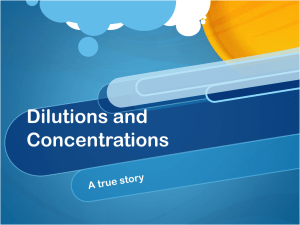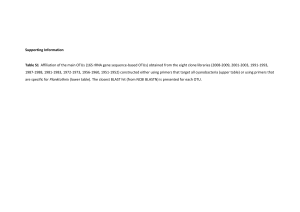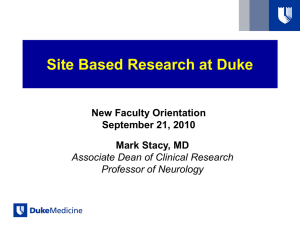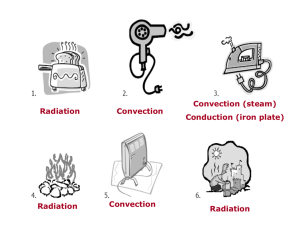History of Life
advertisement
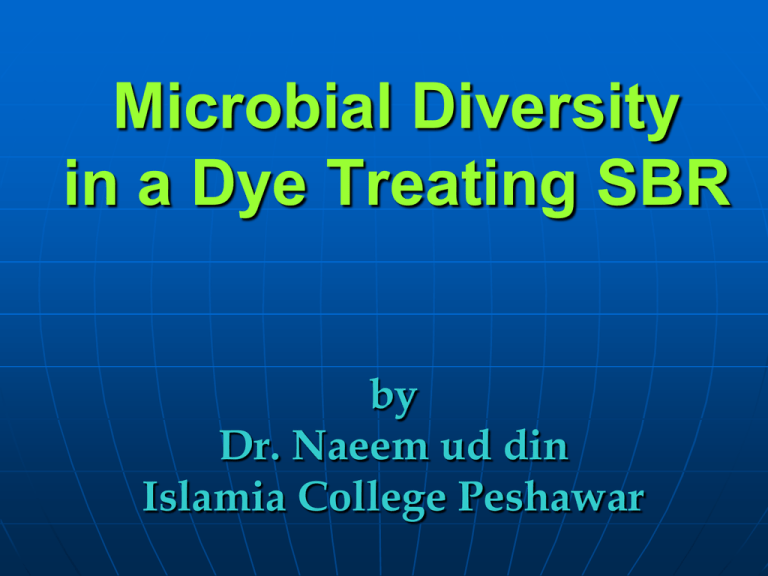
Microbial Diversity in a Dye Treating SBR by Dr. Naeem ud din Islamia College Peshawar Biotreatment Different modes A: using mixed culture B: isolated organisms C: isolated enzymes Dyes are hard to degrade, and often result in harmful intermediates 8 7 9 5 1 2 3 7 4 7 m g / L p H 6 7 Schematic diagram of the experimental setup .of the nitrifying - Figure 3.1 bioreactor. (1), feed tank; (2), feed pump; (3), Air pump; (4), Air meter; (5), oxidation tank; (6), Settler; (7), pH, DO, probes data Logger; (8), Microprocessors for controlling the cycles; (9), stirrer. A Specially Designed Airlift BR from a previous Experiment for SND achieving was used The Nitrogen Removing Process was well established in that Reactor 93 % of Ammonia and COD at an HRT of 12 hrs. Table 1. Physical and Operational Conditions of the SBR Parameter Value Working volume (L) 3.5 Temperature (oC) 25 - 30 Dissolved oxygen (mg/l) 0.05 - 2.0 pH of bioreactor 6.5-8.6 Aeration: No aeration(minutes) 30: 120 The NITRIFYING MEDIUM Constituents NH4Cl (mg N L-1 ) NaCl (mg L-1 ) C6H12O6 (mg/L) FeSO4 (mg L-1 ) K2HPO4 (mg L-1 ) CaCO3(g L-1 ) Trace metal solution(ml/L)* Yeast Extract(mg L-1 ) pH Quantity 120 1000 1000 55.00 140.00 2.00 2 10 7.8 *g/l; MgSO4·7H2O: 5, FeCl2·4H2O: 6, COCl2: 0.88, H3BO3: 0.1, ZnSO4·7H2O: 0.1, CuSO4: 0.05, NiSO4: 1, MnCl2: 5, (NH4)6MO7O24·4H2O, 0.64 and CaCl2·2H2O: 5. MG dye- textile industry, biological stain and antifungal. phytotoxic, a respiratory poison, and teratogen This SBR was subjected to gradually increasing dye concentration Optimization was achieved at a dye concentration of 25 mg/l and increased HRT of 36 hrs In this experiment we used the activated sludge as a renewable biological resource to adsorb the usual environmental concentrations of the MG dye. Synthetic DYE CONTAINING wastewater composition Constituents Quantity NH4Cl (mg N L-1 ) 120 NaCl (mg L-1 ) 1000 C6H12O6 (mg/L) 1000 FeSO4 (mg L-1 ) 55.00 K2HPO4 (mg L-1 ) 140.00 CaCO3(g L-1 ) 2.00 Trace metal solution(ml/L)* 2 Yeast Extract(mg L-1 ) 10 MG (mg L-1 ) 25 pH 7.8 *g/l; MgSO4·7H2O: 5, FeCl2·4H2O: 6, COCl2: 0.88, H3BO3: 0.1, ZnSO4·7H2O: 0.1, CuSO4: 0.05, NiSO4: 1, MnCl2: 5, (NH4)6MO7O24·4H2O, 0.64 and CaCl2·2H2O: 5. In that optimized state The Color and COD removal was 80 % ammonia removal declined to 70 %. Biomass, 4 + 0.7 to 6 + 0.5 gm/l, SVI was in the range of 30 to 65 ml/gm COD & Color removal dye concentration(mg/L) % Removal 5 10 15 20 25 30 35 40 45 50 55 60 100 12 85 10 8 70 6 55 Color COD pH Poly. (Color) Poly. (COD) 40 4 2 0 25 7 14 21 28 35 42 49 56 63 70 77 84 Time(day) 0.9 0.8 λmax 618 nm ----0 hr ----2 hr ----4 hr ----6 hr Absorbance 0.7 0.6 0.5 0.4 0.3 0.2 0.1 0 700 661 621 581 541 501 461 421 381 341 301 261 Wave length(nm) UV-Vis spectrophotometric scan of the biodecolorization of malachite green. 221 Correlation between ammonia, biomass, dye concentration and OUR OUR A B c Knowledge about the microbial community in a dye treating reactor would be useful in association with operational conditions, to eliminate the pollutants efficiently. likely to cause the domination of certain groups of bacteria This aspect inspired our interest to know the microbial community evolved under the selective pressure of the Dye in the SBR. Microbial community structure in the Dye Treating SBR Sludge 16S rRNA gene Library Phylogenetic Analysis PCR-amplification, clone library construction and sequencing Bacterial universal primers 27F (3′-AGAGTTTGATCATGGCTCAG5′) and 1492R (3′TACGGYTACCTTGTTACGACTT-5′) were used for amplification. BLAST Analysis of the OTUs (culture- independent) Taxon -Proteobacteria -Proteobacteria -Proteobacteria -Proteobacteria Verrucomicrobia OTU* Clones/ Phylotype Closest Relative Source in NCBI Homology HT-21 2 Caulobacter crescentus CB15 AE005673 97 % HT-16 1 Azospirillum rugosum AM419042 97 % HT-96 2 U. beta proteobacterium clone 56S_1B_81 DQ837278 97% HT-64 2 Unc. Beta. Proteobac DQ676335 99 % HT-72 1 Burkholderia seudomallei EU024169 91% HT-20 1 Un. beta proteobacterium clone LKC3_102B.28 EF121350 96 HT-69 1 Uncultured Thiobacillus AM167943 95 % HT-43 1 Hydrogenophaga sp. DQ854968 99 % HT-32 4 Ralstonia sp. AY509958 100 % HT-47 1 Bacterium N57 EF207564 92 % HT 42 2 Pseudomonas fluorescens strain P17 EF552157 98 % HT-62 7 Acinetobacter haemolyticus AY586400 99 % HT-44 1 Stenotrophomonas maltophilia AB294557 99 % HT-7 8 Hydrocarboniphaga effusa AY363245 95 % HT-73 2 Bacteriovorax sp. AY294218 97 % HT-13 2 Uncultured delta EF562566 HT-67 1 Desulfovibrio carbinolicus DQ186201 98 % HT-12 1 Uncultured eubacterium AF050559 94 % HT-49 3 Uncultured bacterium EU192216 100 % HT-66 1 Uncultured bacterium EF614090 97 % HT-93 1 Uncultured bacterium AY376698 100 % HT-30 1 Uncultured bacterium DQ413112 99 % 99 % Unclassifiable Phylogenetic analysis The obtained sequences were edited and aligned using the BioEdit software and CLUSTAL_W program (Thompson, 199724). The sequences were compared to the known GenBank sequences using Basic Local Alignment Search Tool (BLAST). Phylogenetic trees were constructed by neighbor-joining method with the MEGA package . Identical sequences were recognized by phylogenetic tree analysis. Phylo-genetic analysis If the sequences similarity was more than 97 %, they were considered as identical and used for further phylogenetic analysis as an operational taxonomic unit (OTU). HT-64*-27F Uncultured beta DQ676335 HT-20*-27F HT-96*-27F Uncultured beta DQ837278 HT-69*-27F Uncultured Thiobacillus AM167943 Beta Proteobacteria HT-43*-27F Hydrogenophaga sp.DQ854968 HT-72*-27F Burkholderia pseudomallei EU024169 HT-32*-27F Ralstonia sp.AY509958 HT-47*-27F Bacterium N57 EF207564 HT-44*-27F Stenotrophomonas maltophilia AB294557 HT-7*-27F Hydrocarboniphaga effusa AY363245 HT-42*-27F Pseudomonas fluorescens EF552157 Gamma Proteobacteria HT-62*-27F Acinetobacter haemolyticus AY586400 HT-93*-27F Uncultured bacterium AY376698 HT-49*-27F Uncultured bacterium EU192216 HT-16*-27F Azospirillum rugosum AM419042 HT-21*-27F Caulobacter crescentus AJ227757 Alpha Proteobacteria HT-30*-27F Uncultured bacterium DQ413112 HT-73*-27F Bacteriovorax sp.AY294218 Desulfovibrio carbinolicus DQ186201 HT-67*-27F Delta Proteobacteria Uncultured delta EF562566 HT-13*-27F HT-12*-27F Uncultured eubacterium AF050559 HT-66*-27F Uncultured bacterium EF614090 0.02 Verrucomicrobia CultureIndependent Phylogenetic tree of the clones from the dye treating SBR, Phylogenetic distribution profile of microbial community (Culture Independent) in the SBR. Culture-Dependent Method Nineteen isolates were selected from the SBR and their 16S rRNA genes were sequenced, and compared with similar sequences of the reference organisms BLAST search. Figure 6 shows the phylogenetic tree based on the culture dependent isolates identified with sequences of the NCBI BLAST. Some of the clones identified with the well-known biodegraders, the notable being Dokdonella koreensis, Rhodobactor, Shingomonas and Paracoccus species. Similarity of 16S rRNA gene sequences of the isolates d l Taxonomic Group Alphaproteobacteria Rhizobiales Rhodobacterales Sphingomonadales Gammaproteobacteria Xanthomonadales Clone No.No Is Cdl2 Closest Relative Homology Sinorhizobium sp. Source in NCBI AM084032 ml26 X.tagetidis X99469 99 % ml 28 Rhodopseudomonas palustris AB017261 99 % Cdl5 Catellibacterium nectariphilum AB101543 99% Cdl8 Phyllobacteriaceae bacterium AM403241 99% Cdl1 Rhodobacter sphaeroides D16424.1 100% 99% Cdl6 Haematobacter missouriensis DQ342315 97% Cdl4 Cdl11 cdl14 Cdl12 Sphingomonas sp. DS4 EF494189 99 % Sphingomonas taejonensis AF131297 99% Dokdonella koreensis strain NML 01-0233 EF589679 100 % AJ698726 98 % DQ988316 100 % DQ787731 97 % DQ814239 99 % EU184871 100% DQ066439 99% ml 23 Actinobacteria Actinomycetales 25 Unclassifiable Cdl 10 Cdl 13 ml 22 cdl 8 Cdl 9 cd14 Microbacterium hydrocarbonoxydans Uncultured bacterium clone LR A2-35 Uncultured bacterium clone SLB728 Uncultured bacterium clone aab65g10 Uncultured bacterium clone WBB38 Estrogen-degrading bacterium Paracoccus kawasakiensis AB041770 Catellibacterium nectariphilum AB101543 cd15 cdl10 Uncultured bacterium DQ988316 cdl13 Haematobacter missouriensis DQ342317 cdl1 Rhodobacter sphaeroides RCAIL106G Uncultured alpha AJ871061 cdl6 cdl7 lm-26 X.tagetidis X99469 cdl9 Uncultured bacterium EU184871 Ochrobactrum sp.EF125188 cdl8 Uncultured bacterium DQ814239 cdl2 Sinorhizobium sp.AM084032 lm-28 Rhodopseudomona palustris AB017261 cdl12 Sphingomonas sp.AF131297 cdi 4 cdl11 cdl14 Sphingomonas sp. EF494189 lm-22 Uncultured bacterium DQ787731 lm-27 Alpha proteobacterium AM411928 lm-23 Dokdonella koreensis EF589679 lm-25 Microbac. hydrocarbonoxydans AJ698726. 0.02 The isolates Identified with - & - Proteobacteria Phylogenetic tree of isolates from the dye treating SBR Phylogenetic distribution, as illustrated by isolates in the SBR involved in the biotreatment MG. Rhizobiales 16% Unclassifiable 32% Rhodobacterales 21% Actinomycetales 5% Xanthomonadales 5% Sphingomonadale s 21% All these groups well represented in the polluted environments Table 2 shows the phylogenic affiliation and abundance of the clones. The sequences identifying with 5 divisions of Proteoabacteria i.e ά-, β-, γ- §-proteobacteria and Verrucomicrobia groups were obtained. The β-, and γproteobacteria were in high abundance, valuing 24 % and 45 % of the total clones. The other small groups, consisting of ά-,§proteobacteria and Verrumicrobia groups, were 4 %, 9 % , and 2 % respectively. A moderate amount of clones, about 9 %, ranked with the uncultured bacterial strains with sequenced data in the NCBI. The similarity of six culture independent clones(HT-69, HT-47, HT51, HT-66, HT-38, HT-7, HT-72), to the known sequences in the GenBank was lower than 95%. Due to difficulty in translating 16S rRNA gene sequence similarity values into nomenclature, it is assumed that similarity values to the known sequences below 95% may be regarded as evidence of the discovery of novel species(3). Thus there is ample possibility of unidentified bacteria in the SBR used in the present study. inferences Θ Θ SBR with good SVI, effectively removed MG, COD and nitrogen up to 25 mg/L dye, above which a strong inhibition of these processes was observed. The autotrophic nitrifying bacteria were not detected at high dye concentration, acting as bio-indicators for the MG toxicity. The ammonia removal pathway was, however, present, an indication of the microbial redundancy. inferences Θ Θ Θ Majority of the sequences identified with the β- and γProteobacteria. pollutant degrading bacteria, like rhodobacterales, sphingomonadales were in plenty. The first time that MG treated in a nitrifying BR, with its inhibitory effects, and microbial community monitored. Both culture-dependent and Culture independent methods must be used to have a true picuture of microbial diversity. References Aksu, Z.(2005). Application of biosorption for the removal of organic pollutants: a review. Process. biochem. 40, 997–1026. Altschul, S. F.; Gish, M. W.; Myers, W.; Lipman, D.J.(1990). Basic local alignment search tool. J. mol. biol. 215, 403-410. Amann, R.I.; Ludwig W.; Schleifer K.H. (1995).Phylogenetic identification and in situ detection of individual microbial cells without cultivation. FEMS microbiol. rev. 59, 143169. Azmi, W.; Kumar, R.; Sani & Banerjee, U.C. (1998). Biodegradation of triphenylmethane dyes. Enzyme. microb. technol. 22, 185-191. Cabral, G. I.; Penha, S.; Matos, M.; Santos, A. R; Franco, F.; & Pinheiro, H.M. (2005). Evaluation of an integrated anaerobic /aerobic SBR system for the treatment of wool dyeing effluents. Biodegradation. 16, 81-89 Cha, C.J.; Daniel R.D.; Carl, E.C. (2001). Biotransformation of malachite green by the fungus Cunninghamella elegans. Appl. Environ. Microbiol. 67, 4358-4360 Chen, K.C.; Wu, J.Y.; Liou D.J.; Hwang, S.C.J. (2003). Decolorization of the textile dyes by newly isolated bacterial strains. J. biotechnol. 101, 57–68. Daneshvar, N.; Ayazloo, M.; Khataee. A.R.; Pourhassan, M. (2007) Biological decolorization of dye solution containing Malachite Green by microalgae Cosmarium sp. Bioresource Technology. 98, 1176-1182. Govoreanu, R.; Seghers, D.; Nopens, I.; Clercq, B. D., Saveyn, H.; Capalozza, C. (2003). Linking floc structure and settling properties to activated sludge populations dynamics in an SBR..Wat. Sci. Tech. 47, 9-18. Hitz H.R.; Huber, W.; Rud, R.H.(1978). The adsorption of dyes by activated sludge, J. Soc. Dyers. Colour. 94: 71–76. Hong, J.; Otaki, M. (2003). Effects of photocatalyis on biological decolorization reactor and biological activity of isolated photosynthetic bacteria. J. Biosci. Bioeng. 96, 298-303. Jiang, H.L.; Tay, J.H.; Tay, S.T.L.(2004). Changes in structure, activity and metabolism of aerobic granules as a microbial response to high phenol loading. Appl. Microbiol.Biotechnol. 63, 602–608. Kandelbauer, A.; Guebitz G. M.(2005). Bioremediation for the Decolorization of Textile Dyes — A Review. Environmental Chemistry, Springer Heidelberg Kipopoulou, A.M.; Zouloulis, A.; Samara, C.; Kouimtzis, Th. (2004). The fate of lindane in the conventional activated sludge treatment process, Chemosphere. 55, 81–91. Kumar, S.; Tamura, K.; and Nei, M. (2004). MEGA3: Integrated software for Molecular Evolutionary Genetics Analysis and sequence alignment. Briefings in Bioinformatics. 5, 150-163. Shi-Quan, N.; Jun, F.; Ying, J.; Yuichi, I.; Tohru, U.; Satoshi, M. (2006). Analysis of bacterial community structure in the natural Circulation system wastewater bioreactor by using a 16S rRNA gene clone liberary. Microbiol. Immunol, 50, 937950. Ong, S-A.; Toorisaka E.; Hirata, M.; Hano, T. (2005). Treatment of azo dye Orange II in aerobic and anaerobic-SBR systems. Process Biochem. 40, 2907-2914 Rai, H.S.; Singh S.; Cheema P.P.S.; Bansal T.K.; Banerjee U.C. (2007). Decolorization of triphenylmethane dye-bath effluent in an integrated two-stage anaerobic reactor. J. Environ. Manage. 83, 290–297 Saitou, N.; Nei, M. (1987). The neighbour-joining method: a new method for reconstructing phylogenetic trees. Mol. Biol. Evol. 4, 406-425. Sani, R.K.; Banerjee, U. C. (1999). Decolorization of triphenylmethane dyes and textile dye-stuff effluent by Kurthia sp. . Enzyme. microb. technol. 24, 433-437. American Public Health Association.(1998). Standard Methods for the Examination of Water and Wastewater. 19th ed. Washington, DC, USA. Thompson, J.D.; Gibson, T.J.; Plewniak,F.; Jeanmougin, F.; Higgins, D.G. (1997). The CLUSTAL_X windows interface: Flexible strategies for multiple sequence alignment aided by quality analysis tools. Nucleic Acids Res. 25, 4876-82. Xu, P.; Qian X. M.; Wang, Y. X.; Xu. Y.B. (2004). Modeling for waste water treatment by Rhodopseudomonas palustris Y6 immobilized on fiber in a columnar bioreactor. Appl Microbiol Biotechnol . 44, 676-682. Zilouei, H.; Soares, A.; Murto, M. (2006). Influence of temperature on process efficiency and microbial community response during the biological removal of chlorophenols in a packed-bed bioreactor. Appl Microbiol Biotechnol. 72, 591-599. Thanks


